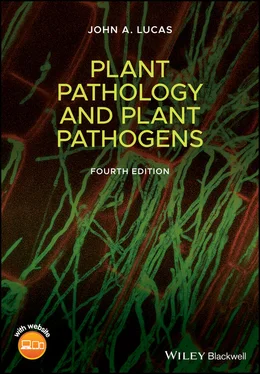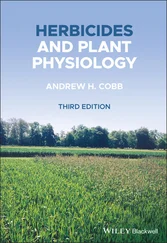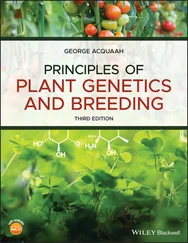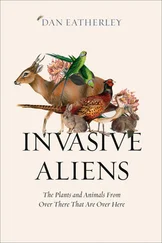The advantage of this scheme is that it can accommodate relationships where the balance may shift from mutual benefit, termed mutualism, to injurious effects on one partner.
If one considers the terms parasite and pathogen from the reverse viewpoint, in other words the ability to cause disease, the difference becomes more obvious. While all parasites are potentially pathogenic due to their diversion of host nutrients, many of the characteristic symptoms of disease cannot be explained on the basis of nutritional stress alone. The growth and development of a pathogen in its host, along with the response of the host to the presence of an alien organism, involve other interactions which have little to do with nutrition. Many of the more injurious effects of pathogens may be traced to toxic chemicals whose production may be incidental to their parasitic way of life (see Chapter 8). Looked at in this way, the statement “a good parasite is a poor pathogen” may appear to be justified. Any organism which is dependent upon another organism for its supply of nutrients might be expected to restrict its pathogenic effects to a minimum.

Figure 2.1 Symbiotic relationships: + positive effects on partner; − negative effects on partner.
Biotrophs and Necrotrophs
Although there is an enormous variety of pathogens, an important distinction can be made between those which rapidly kill all or part of their host and others which co‐exist with host tissues for an extended period without inflicting severe damage. The former category, referred to as necrotrophs, are often opportunist pathogens which invade wounds and juvenile or debilitated plant tissues. They grow intercellularly, producing cytolytic factors and then utilize the dead host tissues as a resource. The ability to attack a living host distinguishes these organisms from the saprotrophswhich subsist exclusively on organic debris. In contrast, biotrophsdo not kill their host immediately. They are, in fact, dependent upon viable host tissue to complete their development. Extreme biotrophy resembles mutualism in that it is difficult to discern any marked pathogenic effects.
Figure 2.2shows two contrasting diseases of faba beans, both caused by fungi. In the first, chocolate spot caused by Botrytis fabae , the main symptom is dark necrotic lesions in which host cells have died. As the disease progresses the lesions expand and eventually coalesce to destroy the whole leaf. In the second, bean rust caused by Uromyces viciae‐fabae , the leaves are covered with pustules producing rust‐colored spores, but the tissues around the pustules are still green and alive The rust penetrates living cells and absorbs soluble nutrients that are then transported back into the center of the pustules to fuel spore production. Over time, this process will impact on the physiology and development of the host plant, but tissues are not directly destroyed by the pathogen.

Figure 2.2 Faba bean leaves infected by Botrytis fabae ( left ) showing necrotic lesions, and bean rust, Uromyces viciae‐fabae ( right ) with pustules producing rust‐colored spores.
Table 2.1 Main characteristics of necrotrophic and biotrophic pathogens.
| Necrotrophs |
Biotrophs |
| Morphological and biochemical features |
| Host penetration via wounds or natural openings |
Host penetration direct or via natural openings |
| Few special parasitic structures formed |
Special parasitic structures, e.g., haustoria, typically formed |
| Host cells rapidly killed |
Living host–pathogen interface |
| Toxins and cytolytic enzymes produced |
Few or no toxins or cytolytic enzymes produced |
| Nutrients obtained from breakdown of host substrates |
Nutrients diverted from host cells |
| Destruction of host resistance |
Suppression or evasion of host resistance |
| Ecological features |
| Wide host range |
Narrow host range |
| Able to grow saprophytically away from host |
Unable to grow away from host |
| Attack juvenile, debilitated or senescing tissues |
Attack healthy hosts at all stages of development |
The contrasting features of necrotrophs and biotrophs are summarized in Table 2.1. Biotrophs, in keeping with their more specialized parasitism, usually attack only a limited range of hosts. Biotrophic fungi like the rusts form differentiated infection structures including modified intracellular hyphae termed haustoria(see Chapter 6). Generally, these fungi do not produce large quantities of extracellular enzymes or toxins; during their co‐evolution with the host, synthesis of hydrolytic enzymes may have been repressed or limited to localized sites where host cells are penetrated. Eventually, the ability to elaborate such enzymes may have been lost altogether.
An alternative view of these different lifestyles is that necrotrophs may have evolved from biotrophs through an increasing ability to produce enzymes capable of degrading complex substrates. This theory proposes that the first fungi were dependent on living plants, but gradually evolved independence by developing enzyme systems able to deal with polymeric carbon sources in plant litter. Such schemes can therefore be extended to include free‐living saprotrophs but in the absence of any adequate fossil record, both versions are speculative. The advent of techniques for analyzing genome structure and molecular phylogeny may, however, provide fresh evidence to support or refute such evolutionary models.
A human analogy for these contrasting types of parasite has been proposed, as follows: necrotrophs are “thugs” while biotrophs are “con artists,” reflecting their more devious way of obtaining resources from the host plant. However, the original idea that necrotrophs are unsophisticated pathogens is now being revised as we learn more about their strategies for invading plants and overcoming host defense. It turns out that some have the capacity to hijack host pathways, leading to programmed cell death, thereby releasing nutrients for their own use.
The impression may have been given that biotrophy and necrotrophy represent absolute categories; in reality, there is a continuous gradation between the two types of pathogen. At one extreme are the viruses, which can replicate only within living cells, and fungal biotrophs, such as the rusts and powdery mildews. At the other extreme are necrotrophs, such as the damping‐off fungi and soft‐rot bacteria. In between, one encounters pathogens with intermediate characteristics. For instance, the potato late blight pathogen Phytophthora infestans exhibits a high degree of host specificity and other biotrophic features such as haustoria, but it also causes relatively rapid necrosis of invaded tissues. Many pathogens pass through both a biotrophic and a necrotrophic phase during their life cycle. Plant pathogenic bacteria such as Pseudomonas syringae initially proliferate in intercellular spaces in leaves or fruits without apparent damage to host cells, but water‐soaked lesions which become necrotic then appear. The apple scab fungus Venturia inaequalis grows beneath the cuticle of host leaves for several days without causing obvious necrosis, but as the lesions age, the host tissues are eventually killed and the typical scabs develop ( Figure 2.3). Some species of the anthracnose fungus, Colletrotrichum , penetrate directly into host cells which remain alive for several days (see Chapter 6, Figure 6.9); subsequently, necrotic, spreading lesions are formed. The term hemibiotrophhas been used to describe such behavior. The factors responsible for this switch from a balanced mode of parasitism to rapid killing of host cells have in many cases not yet been identified.
Читать дальше













